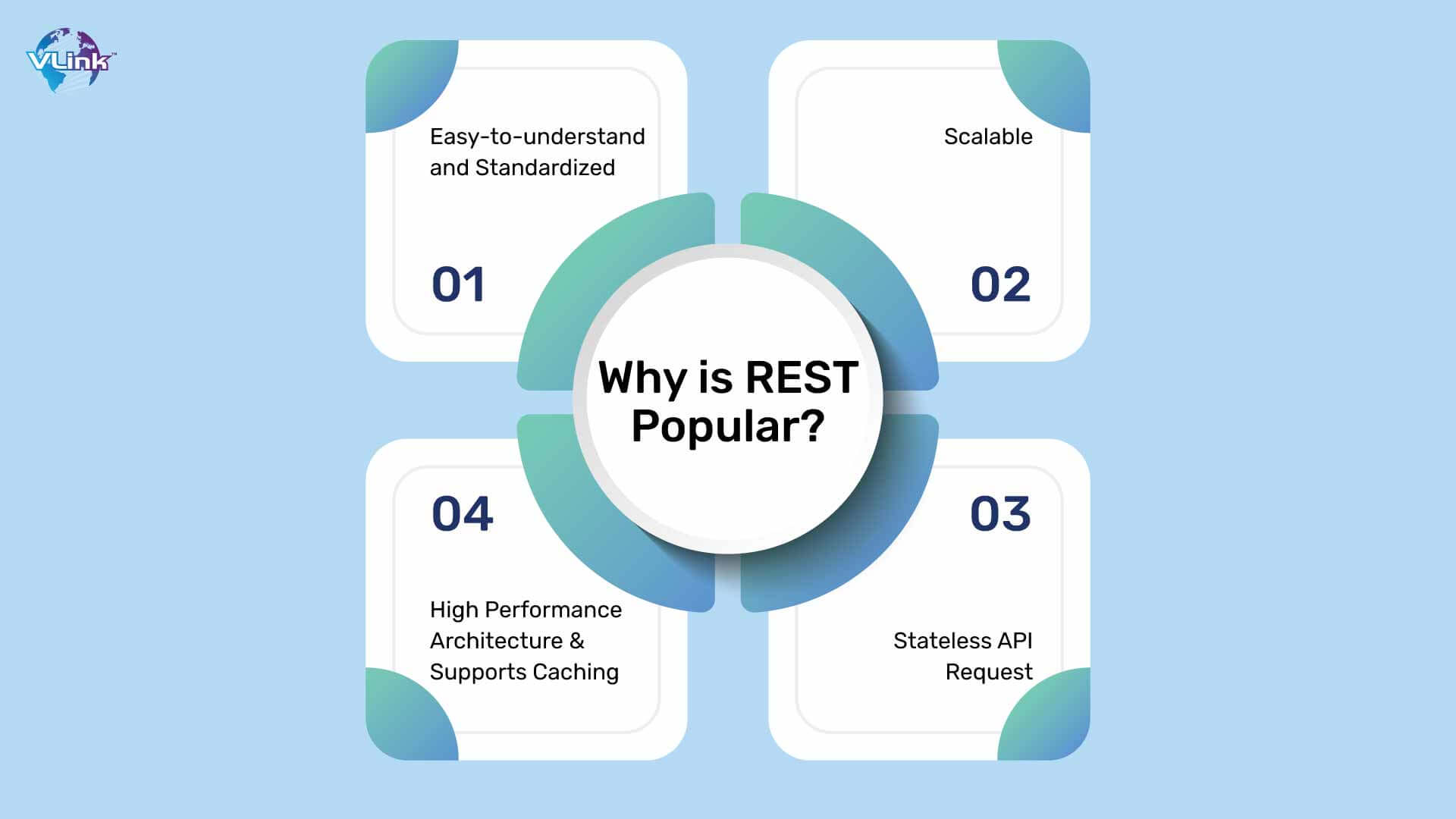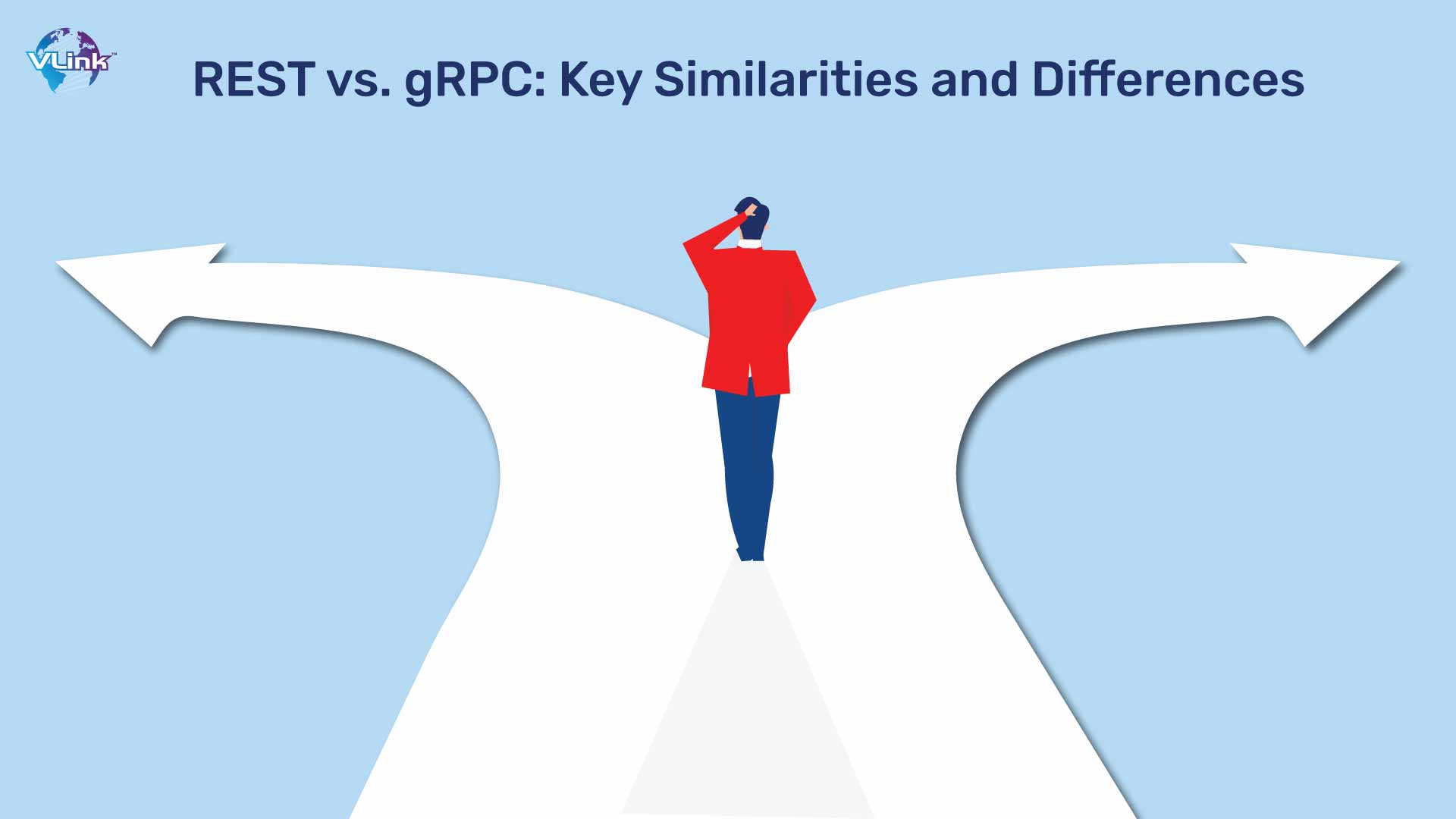What should you choose—gRPC or REST?
Well, you are not alone in this dilemma. This question has been a common debate among developers lately in the modern web development industry.
For the uninitiated, both gRPC as well as REST are broadly utilized for creating APIs. But of course, they are two completely different things.
In this blog, we will dive into the basics of gRPC and REST including the differences, similarities, and more. By the end you should be able to decide which is right for your next project.
So, shall we get started?
An Overview of gRPC
In simpler language, gRPC is a system that permits implementing traditional RPC but formulated with numerous improvements.
For those who do not know, RPC is denoted in gRPC stands for Remote Procedure Call model.
The gRPC APIs utilize protobufs to converse. While the proto files are firstly serialized into a binary composition and forwarded to the server and later deserialized into the original composition on the server side—and that’s how gRPC works with protobuf.
Also, gRPC has different communication forms. Although they use HTTP, the client or the server can never learn or see how the gRPC request is directly mapped to the HTTP protocol. REST using JSON only is something we already know. Likewise, gRPC also uses protocol buffers for serialization and communication.
Must-Know Features of gRPC

Take a look at the four features of gRPC that make it effective and powerful:
Single Request
It works with simple request-response communication, i.e., the client sends the proto request and when the server receives the same, it waits some time to do some process but then returns response.
Server Streaming
When a single request is shared, a lot of responses come from the server. Say, for instance, you click on the video, and a lot of video-related data is shown from the server side.
Client Streaming
Client streaming is entirely opposite from server streaming. In this, a client shares multiple data or messages on the server and the server responds with only a single message.
Bi-Directional Streaming
Here, both the client and the server share multiple messages. One of the best examples of this communication is chatting.
How do gRPC APIs Work?
Google launched GRPC in 2015. It was built as an evolution of the RPC structure to create faster data exchange between microservices and any other systems that had to interact with each other. Without any doubt, the API (Application Programming Interface) structure was vastly different from APIs that were developed before for several reasons.
Firstly, gRPC uses a different format. Instead of JSON, it applies Protobuf. As a language and platform-neutral format, Protobuf was also developed by Google. It can be seen as something similar to XML, although Protobuf is much more efficient.
The gRPC API structure uses HTTP2 and not the “obsolete” HTTP1 and, in comparison with the original RPC, serves messages much faster. In other words, it is easier to implement and transmits messages 10X quicker than the previous version. Moreover, gRPC uses its own private code generation instead of Swagger for communication.
When to Use gRPC?
We have already provided you with a few use cases of gRPC while discussing features. To understand how you can actually use gRPC, let us give you another example which will clear all your doubts.
So, imagine you want to build a chat application. In this case, you cannot utilize the REST API since it does not support fast bi-directional communication streaming. Obviously, this means that you will use the gRPc, and besides the speed, it can also provide you with a number of advantages.
And, as we mentioned discussed in the earlier section — gRPC has a language-neutral behavior. In simpler terms, it does not matter what programming language the server or other clients are writing. The only condition is until message structure is accepted— it is possible to communicate. And with this very feature, the Android version of your chat application can communicate with the iOS version and vice versa.

Common Issues Faced With gRPC

Every coin has two sides—a good side and a bad side. Likewise, people face issues with gRPC as well.
Have a look:
Limited Browser Support
gRPC uses HTTP 2, so often it becomes difficult or even impossible to call the gRPC service directly from the browser, which sometimes requires setting up a proxy.
Non-Readable Form
It is no news that gRPC uses a binary structure, which cannot be easily read by humans. This is a huge disadvantage in some cases.
Lack of Maturity
The gRPC came into existence in 2015. Needless to say, it is immature compared with REST and many bugs and problems need to be fixed.
Learning Problems
Rest and GraphQL use JSON that is comparatively easier to learn, so most people will find it hard to switch from it right away. Protobuf, on the other hand, is a new and complicated topic, which will make it further difficult to find gRPC professionals.
An Overview of REST
Then REST APIs came into existence after the boom of JavaScript. Consequently, even the JSON file organization quickly grew. Needless to say, REST was quite simple and convenient in contrast to almost all APSs.
In terms of the concept, the REST APIs message structure consisted of several keys and value pairs.
If we describe REST in plain words, it is a set of “rules” for transferring JSON messages on the Internet, making HTTP the protocol.
In other words, using REST, you will never need to define a scheme.
Why is REST Popular?

Here are some of the top reasons behind the growing popularity of REST:
Easy-to-understand and Standardized
While using REST, you do not have to stress yourself formatting your message or data. Additionally, you will never have to bother with your message structure as it is all certified as well as industry used.
Scalable
Eventually, your services will expand, and you will require more functionality. However, you will be able to revamp your server without stressing up the overall efficiency of REST of the server. Further, new functions can be built in absolute isolation unless they are messing up your data.
Stateless API Request
By stateless API request, we mean that each request will contain a piece of data that the server should know. The server’s architecture allows the server to remember this request, but, in REST API architecture, the session state is stored on the client side, making the server faster and consuming less effort for smooth performance
High Performance Architecture & Supports Caching
REST’s powerful caching mechanism guarantees high performance by storing used information to access data faster, which reduces server workload and network slowness.
When to Use REST?
Let us give you a simple example!
Suppose you are creating a social media platform, and the users can post, like, and comment on photos.
Using REST, you can divide resources like users, posts, and comments into separate API endpoints. These endpoints will enable actions like getting posts or changing user profiles.
This structure will ensure efficient data control and scalability, which will make REST a perfect solution for all kinds of web applications.
Common Issues Faced With REST
Just like gRPC, REST too has some drawbacks that you must know about:
The first disadvantage of REST is the need for bi-directional communication. What if the server needs to send some data to the client, or the mean server wants to communicate? This is certainly impossible in the REST architecture. You can, of course, use some tricks; however, none of them will be practical.
Imagine you created a live score website. How do you control the server to send a request to the client for updating the score data? You may let the client send a request every 10 seconds or at any other interval. But this can never be considered as good practice. Firstly, it makes the server overload. As a result, that may cause speed problems. It is the biggest issue with REST.
REST architecture is requested and response. It does not provide data streaming, or rather continuous event processing; which again is a substantial inconvenience along the way
The stateless property of REST is both good and bad as one can never choose the state of data on REST architecture.
REST vs. gRPC: Key Similarities and Differences

Key Similarities of REST and gRPC
Here are some basic similarities between REST and gRPC :
Cross-platform compatibility:
REST and gRPC are independent platforms. This enables services built-in distinct programming languages and platforms to communicate with one another.
Interoperability:
REST and gRPC make heterogeneous system communication possible. Therefore, this allows services developed using various technology and framework to communicate.
Serialization:
Both REST and gRPC enable serialization to transfer data over a network. While REST uses JSON and XML to serialize data, gRPC utilizes Protobuf.
Ease of Use:
REST as well as gRPC are relatively easy to use and understand, a factor that makes them suitable alternatives to developers of any level of experience.
Scalability:
Both REST and gRPC offer scalability benefits. This often helps systems to handle increasing workloads by distributing services across different instances.
Key Differences of REST and gRPC
Now that you know the similarities between gRPC and REST, it is time to explore the common differences between them:
Message Format
In REST, the structure of message format is mostly in JSON, and sometimes, it is in XML, which is the most acceptable format and apprehensible by human. In Rest, you need not to be concerned about the schema.
On the contrary, gRPC uses a protocol buffer to serialize the data. The compressed one is shorter and moves far faster. In addition, it is in a binary structure, so it serializes and deserializes data to pass it out.
HTTP 1.1 and HTTP 2
The Rest API always uses HTTP 1.1 as its protocol. However, the other side, gRPC uses HTTP 2 as its protocol. Although Rest APIs can use HTTP 2, it is still limited due to the request-response method.
On the contrary, gRPC APIs use HTTP 2 and allow client-response and support of the bi-direction communication of HTTP 2. It is another reason for gRPC performance is best in REST.
Payload Limit
While sending outgoing messages, Rest has a maximum payload limit of 45MB. GRPC, on the other hand, does not have any such limit. This certainly means your outgoing message can be as heavy as you want.
Safety
REST is less secure as it uses HTTP 1.1 protocol as well as JSON structure, which is easier to access and decrypt.
Since GRPC uses HTTP 2, it is comparatively safer. Also, it uses Protobuf that cannot be decrypted that easily.
Speed
gRPC is also a clear winner when it comes to speed. GRPC provides 10X more speed than REST—reason remain the same—HTTP 2 as the protocol and Protobuf as the message format.
The Code Generation Function
Another disadvantage of Rest is that it does not possess built-in code generation capabilities. This means that the developer requires third-party apps to create the API code.
On the contrary, gRPC has inherent code-generation capabilities due to the protobuf compiler that operates in different programming languages. This, too, may be a massive advantage, particularly in microservice architectures.

Hire Dedicated .NET Developers with VLink
Hire dedicated .NET developers through VLink to gain access to unmatched expertise in both gRPC and REST technologies.
Our dedicated team will assist you with pre-vetted talent who specializes in leveraging the power of gRPC and REST to develop highly robust, scalable, and high-performance applications unique to your business needs.
We have 18 years of experience and know exactly what it will take to help your business remain at the top.
Our developers will provide your business with the solutions it needs. So, what are you waiting for? Get in touch with our team to hire the best .NET developers experienced in gRPC and REST. Let your project make a real difference!







 Shivisha Patel
Shivisha Patel

















